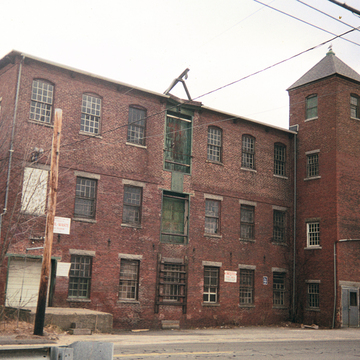Although the Saugus Iron Works failed early, Central Avenue along the Saugus River remained industrial. All-wool flannel became the dominant product in the nineteenth century. In 1832, the New England Wool Company built a four-story brick mill, which Edward Pranker purchased in 1838. He added another mill across Central Street in 1846 and a third in 1861 to expand production of wool shirtings, ladies dress goods, stockings, and flannels. A fire in 1866 damaged the west mills as seen in their low-pitched roofs. In 1864 the top floor of the first mill was replaced and two stories added. At this time a fourth floor was added to the 1846 west mill, and a new steam powerhouse built; its brick stack was added in 1884. By then the Pranker family had acquired 209 Central Street, a typical Federal-period home. For his workers Pranker built, about 1850, eight one-and-a-half-story two-family dwellings, of which 162–164 Central is the last remaining. Purchased by the Saugus Manufacturing Company at the turn of the century, the mills continued to make woolen goods until 1912, when U.S. Worsted Corporation bought the complex to spin yarn for its Lawrence weaving mills.
Between the Pranker Mills and the old Iron Works sits the Scott Mill and its adjacent office (222 Central Street). In 1848 Francis Scott purchased an older, burned-out industrial structure and built a new flannel mill. A typical four-and-a-half-story brick factory, with its slate roof and dentiled cornice, it features a gable end that faces Central Street. In 1917 Colonial Revival entrepreneur Wallace Nutting purchased it as a workshop to reproduce colonial-style furniture; he also published his Windsor Handbook and hand tinted his romantic photographs here until the plant moved to Framingham, Massachusetts, in 1925.


